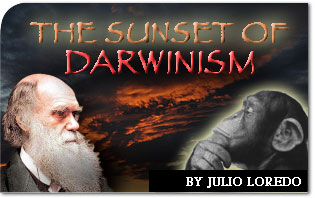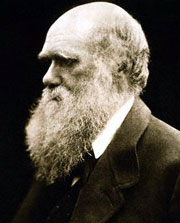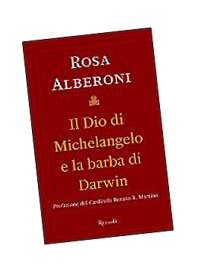 Praised until recently as dogma, Darwin’s theory of evolution is now fading away, discredited by the same science that bore its poisoned fruit. Instead, the Christian vision of a supernatural design is being increasingly affirmed. “Evolution is now a datum proven beyond any reasonable doubt and no longer a theory, it’s not even worth taking the trouble to discuss it.” This is what a spokesman proclaimed at the Festival of Science held in Genoa in November 2005, thereby neglecting a very important aspect of modern science—the need to be open to new perspectives. Instead, the truth is quite the opposite. Paradoxically, evolutionists are taking an ever greater distance from empirical science and are wrapping themselves up in a dogmatism that borders on ideological fanaticism.
Praised until recently as dogma, Darwin’s theory of evolution is now fading away, discredited by the same science that bore its poisoned fruit. Instead, the Christian vision of a supernatural design is being increasingly affirmed. “Evolution is now a datum proven beyond any reasonable doubt and no longer a theory, it’s not even worth taking the trouble to discuss it.” This is what a spokesman proclaimed at the Festival of Science held in Genoa in November 2005, thereby neglecting a very important aspect of modern science—the need to be open to new perspectives. Instead, the truth is quite the opposite. Paradoxically, evolutionists are taking an ever greater distance from empirical science and are wrapping themselves up in a dogmatism that borders on ideological fanaticism. Unprovable Hypothesis
“What is left, then, in evolutionism, that is valid according to the scientific method? Nothing, actually nothing!” This is the conclusion of
 journalist Marco Respinti in his recent book Processo a Darwin (Darwin on Trial, Piemme, 2007). He continues: "Not one of his postulates can be verified or certified based on the method proper to the physical sciences. His whole claim escapes verification. Based on what, therefore, other than on strong prejudices of an ideological nature, can anyone affirm or continue to affirm that the evolutionist hypothesis is true?" Indeed, the consistency of a scientific theory is founded on its capacity to be verified empirically, be it through observation of the phenomenon in nature or by reproducing it in the laboratory. The evolutionist hypothesis fails on both counts. “Thus,” Respinti shows, “Darwinism remains simply an hypothesis devoid of empirical or demonstrable foundation, besides being unproven. . . . The evolutionist hypothesis is completely unfounded for it does not master the very domain in which it launches its challenge.”
journalist Marco Respinti in his recent book Processo a Darwin (Darwin on Trial, Piemme, 2007). He continues: "Not one of his postulates can be verified or certified based on the method proper to the physical sciences. His whole claim escapes verification. Based on what, therefore, other than on strong prejudices of an ideological nature, can anyone affirm or continue to affirm that the evolutionist hypothesis is true?" Indeed, the consistency of a scientific theory is founded on its capacity to be verified empirically, be it through observation of the phenomenon in nature or by reproducing it in the laboratory. The evolutionist hypothesis fails on both counts. “Thus,” Respinti shows, “Darwinism remains simply an hypothesis devoid of empirical or demonstrable foundation, besides being unproven. . . . The evolutionist hypothesis is completely unfounded for it does not master the very domain in which it launches its challenge.” Respinti reaches this “verdict” after a rigorous “trial of Darwin” in which he analyzes the main arguments that debunk the notorious theory, ranging from nonexistent fossil records to the conflict of Darwinism with genetic science and the flimsiness of the “synthetic theory” of neo-Darwinism, without forgetting the countless frauds that have stained notable evolutionists in their insane quest to fabricate the “proofs” that science tenaciously denied them. Respinti concludes by denouncing the ideological drift of the evolutionist school: “To categorically affirm the absolute validity of the theories of Darwinian and neo-Darwinian evolution based on the claim that discussing them would be unscientific by definition, is the worst proof that human reason can give of itself.”
 A Long Sunset
A Long Sunset The sunset of the Darwinist hypothesis has picked up speed over the last two decades. For example, consider the work carried out by the Osaka Group for the Study of Dynamic Structures, founded in 1987, in the wake of an international interdisciplinary meeting convened “to present and discuss some opinions opposed to the dominant neo-Darwinist paradigm.” Scientists from all over the world participated, including the outstanding geneticist Giuseppe Sermonti, then a professor at the University of Perugia, Italy. In 1980, together with Roberto Fondi, now a professor at the University of Siena, Sermonti wrote Dopo Darwin—Critica all’evoluzionismo (After Darwin—A Critique of Evolutionism, Rusconi, 1980). “Biology,” Sermonti explains, “has no proof at all of the spontaneous origin of life, or rather biology has proved its impossibility. There is no such thing as a gradation of life from elementary to complex. From a bacterium to a butterfly to man the biochemical complexity is substantially the same.” For his part, Fondi shows that from the first appearance of fossils to this day, the variety and riches of living beings have not increased. New groups have replaced older ones, but the intermediate forms that the evolutionists have so frantically searched for do not exist. “The theory of evolution,” Sermonti and Fondi conclude, “has been contradicted as have few other scientific theories in the past.”
In Le forme della vita (The Forms of Life, Armando, 1981), Sermonti unveils other obstacles to Darwinism. According to the renowned geneticist, the “random” origin of life and the gradual transformation of the species through “selective change” are no longer sustainable because the most elementary life is incredibly complex and because it is now proven that replacement of living groups takes place “by leaps” rather than “by degrees.” Putting together forty years of experience, in 1999 he wrote Dimenticare Darwin—Ombre sull’evoluzione (Forgetting Darwin—Shadows on Evolution, Rusconi, 1999). With rigorous argumentation, the author demolishes the three pillars of Darwinism: natural selection, sexual mixing and genetic “change.” According to him, history will remember the theory of evolution as the “Big Joke.”
Not Just Creationists
Sermonti has been often accused of being a “creationist” or a “religious fundamentalist” even though he has always said he does not fit his scientific vision into a Christian perspective, and this yet one more aspect to note in the polemic against Darwinism, which many people other than Christians also contest it. In this sense, it is interesting to note the recent editorial in Il Cerchio, “Seppellire Darwin? Dalla critica del darwinismo agli albori d’una scienza nuova,” ("Bury Darwin? From a Critique of Darwinism to the Dawn of a New Science") containing essays by seven specialists including Sermonti, Fondi and Giovanni Monastra, director of Italy’s National Institute for Food and Nutrition Research. The title refers to the famous phrase by Chandra Wickramasinghe, a professor of applied mathematics of the University College of Cardiff, “The probability that life was formed from inanimate matter is equal to 1 followed by 40,000 zeros . . . . It is large enough to bury Darwin and the whole theory of evolution.”
From Dimenticare Darwin—Ombre sull’evoluzione’s introduction: For the first time in Italy, a critique of Darwinism is presented in all its complexity thanks to the interdisciplinary contribution of scholars of several orientations—[b]eyond the polemic between neo-Darwinian fundamentalists and religious integralists, the essay demonstrates how the critique of the now old neo-Darwinist paradigm opens the doors to a new science.
A Crisis of the Positivist Paradigm
Francis Crick, who together with Watson discovered the structure of DNA, openly declared, “An honest man, armed only with the knowledge available to us, could affirm only that, in a certain sense, the origin of life at the moment appears to be rather a miracle,” In the same wavelength, Harold Hurey, a disciple of Stanley Miller who made history with his failed attempt to recreate life in the laboratory from a so-called primordial broth, said, “All of us who studied the origins of life uphold that the more we get into it, the more we feel it is too complex to have evolved in any way.” Indeed, a lot of faith is required to believe in evolutionism, and it is precisely that faith, of a clearly positivist[1] mold, that is now beginning to weaken.
In Darwinismo: le ragioni di una crisi (Darwinism: The Reasons of a Crisis), Gianluca Marletta sticks his finger in the wound by observing that “The crisis of Darwinism is above all a crisis of the philosophical paradigms that allowed its success.” “One cannot understand the origin of this doctrine,” Marletta explains, “without going back to the cultural climate of ‘triumphant positivism’ straddling the nineteenth and twentieth centuries.” According to Marletta, Darwinism constituted a wonderful occasion to strengthen the positivistic view of the world being affirmed at that time. Darwinism represented the perfect tool to transplant, into the biological field, the mechanic and materialist paradigms already imposed on the social sciences. This is the true motive of this theory’s success. A motive that now begins to subside with the crisis of the positivist paradigm. This explains the almost fanatical tenacity with which evolutionists are defending their convictions. “Many fear,” concludes Marletta, “that the fall of Darwinism can bring down with it the whole positivist vision of the world.”
 God’s Comeback
God’s Comeback The crumbling of positivism is bringing back to the limelight issues that a certain conventional wisdom thought to have definitively eliminated. Shaken from the sudden crumbling of old certainties, worried about the chaos that increasingly marks this postmodern age, many people are once again asking the fundamental questions: Does my life have a transcendental meaning? Is there an intelligent project in nature? In short, does God exist? Sociologist Rosa Alberoni wrote about this in her book, Il Dio di Michelangelo e la barba di Darwin (The God of Michelangelo and Darwin’s Beard), published last November by Rizzoli with a preface by Cardinal Renato Martino, president of the Pontifical Council Justice and Peace. The onslaught of “Darwin’s worshippers,” Alberoni explains, is carried out by the “usual destructive atheists obsessed with the goal of stamping out Christ and destroying the Judeo-Christian civilization after having sucked its blood and essence.” This sullen assault, however, in the deeply changed ambience of post-modernity, risks being counterproductive: The monkey myth is what really shook ordinary people. Like soldiers woken up by an alarm in the middle of the night, Christian believers and [O]rthodox Jews prepared for the defense. Or rather for the war, because that is what it has become . . . [o]n the symbolic level, the bone of contention is the ancestor of man: God or a monkey? Should one believe in God or in Darwin? This is the substantial nature of the ongoing clash in our civilization.
In other words, a real war of religion looms in the dawn of the Third Millennium. Precisely that which secularists have tried to avoid at all cost.



